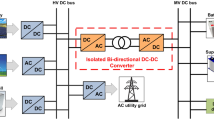Abstract
Impedance network inverters (INIs) have emerged as an alternative to improve traditional inverters, allowing their operation as a buck-boost-type converter, through the utilization of the “shoot-through” conduction state, where switches of one or more inverter legs are gated on simultaneously. Recently introduced, the quasi-Y-source inverter (QYSI) is a INI with magnetic coupling, which has particular operational advantages, specially for renewable sources and distributed generation. To control the QYSI, there are several techniques based on sinusoidal pulse width modulation (SPWM), which are modified to allow the shoot-through state. This work aims to present, through theoretical, simulations and experimental results, a comparative analysis of three SPWM techniques applied in three-phase QYSI, considering a fixed inverter gain factor and a three-phase/three-wire wye-connected R load to the inverter output after a LC filter. The following modulation techniques were compared: simple boost control (SBC), maximum boost control with third harmonic injection (MBC\(_{3h}\)) and maximum constant boost control with third harmonic injection (MCBC\(_{3h}\)). A comparative analysis was performed showing several relationships among voltage gain, switch voltage stress, shoot-through duty ratio and converter design, for the different SPWM techniques. It is shown the advantages and disadvantages of each SPWM technique applied to QYSI, and merit indexes are indicated in order to help to establish proper criteria for choosing among SPWM techniques for three-phase/three-wire power system applications.








Similar content being viewed by others
References
Abdelhakim, A., Blaabjerg, F., & Mattavelli, P. (2018). Modulation schemes of the three-phase impedance source inverters-part ii: Comparative assessment. IEEE Transactions on Industrial Electronics, 65(8), 6321–6332.
Ellabban, O., Van Mierlo, J., Lataire, P., (2009) Comparison between different pwm control methods for different z-source inverter topologies. In: 2009 13th European Conference on Power Electronics and Applications, IEEE, pp 1–11.
Forouzesh, M., Abdelhakim, A., Siwakoti, Y., Blaabjerg, F., (2018) Analysis and design of an energy regenerative snubber for magnetically coupled impedance source converters. In: 2018 IEEE Applied Power Electronics Conference and Exposition (APEC), IEEE, pp 2555–2561.
Grant, D., Houldsworth, J., (1984) Pwm ac motor drive employing ultrasonic carrier. In: IEE Conf. PE-VSD, pp 234–240.
Husodo, B., Anwari, M., Ayob, S., et al. (2010) Analysis and simulations of z-source inverter control methods. In: 2010 Conference Proceedings IPEC, IEEE, pp 699–704.
Liu, Y., Ge, B., & Abu-Rub, H. (2013). Theoretical and experimental evaluation of four space-vector modulations applied to quasi-z-source inverters. IET Power Electronics, 6(7), 1257–1269.
Loh, P. C., Blaabjerg, F., Wong, C. P., (2006) Comparative evaluation of pulse-width modulation strategies for z-source neutral-point-clamped inverter. In: 2006 37th IEEE Power Electronics Specialists Conference, IEEE, pp 1–7.
Peng, F. Z. (1999) Z-source inverters. Wiley Encyclopedia of Electrical and Electronics Engineering pp 1–11.
Peng, F. Z., Shen, M., & Qian, Z. (2005). Maximum boost control of the z-source inverter. IEEE Transactions on Power Electronics, 20(4), 833–838.
Ridley, R. (2005) Flyback converter snubber design. Switching Power Magazine 12
Rostami, H., Khaburi, D. (2009) Voltage gain comparison of different control methods of the z-source inverter. In: 2009 International Conference on Electrical and Electronics Engineering-ELECO 2009, IEEE, pp I–268.
Santos, R., & Gonçalves, F. A. (2020). Sinusoidal pwm techniques comparison for the quasi-y-source inverter. Simpósio Brasileiro de Sistemas Elétricos-SBSE, 1(1), 1.
Santos, R., Gonçalves, F. A. S. (in press) Quasi-y source network: A design and analysis approach for a dc-dc application. IEEE Latin America Transactions
Shen, M., Wang, J., Joseph, A., Peng, F. Z., Tolbert, L. M., Adams, D. J., (2004) Maximum constant boost control of the z-source inverter. In: Conference Record of the 2004 IEEE Industry Applications Conference, 2004. 39th IAS Annual Meeting., IEEE, vol 1.
Shults, T. E., Husev, O. O., Zakis, J. G. (2015) Overview of impedance source networks for voltage source inverters. In: 2015 16th International Conference of Young Specialists on Micro/Nanotechnologies and Electron Devices, IEEE, pp 514–520.
Siwakoti, Y. P., Loh, P. C., Blaabjerg, F., & Town, G. E. (2014a). Effects of leakage inductances on magnetically coupled y-source network. IEEE Transactions on Power Electronics, 29(11), 5662–5666.
Siwakoti, Y. P., Peng, F. Z., Blaabjerg, F., Loh, P. C., & Town, G. E. (2014b). Impedance-source networks for electric power conversion part i: A topological review. IEEE Transactions on Power Electronics, 30(2), 699–716.
Siwakoti, Y. P., Blaabjerg, F., Loh, P. C. (2015) Quasi-y-source inverter. In: 2015 Australasian Universities Power Engineering Conference (AUPEC), IEEE, pp 1–5.
Suganthi, J., & Rajaram, M. (2015). Effective analysis and comparison of impedance source inverter topologies with different control strategies for power conditioning system. Renewable and Sustainable Energy Reviews, 51, 821–829.
Author information
Authors and Affiliations
Corresponding author
Ethics declarations
Conflicts of interest
The authors declare that they have no conflict of interest.
Additional information
Publisher's Note
Springer Nature remains neutral with regard to jurisdictional claims in published maps and institutional affiliations.
This project was financially supported by #2016/08645-9 and #2018/24331-0 grants, São Paulo Research Foundation (FAPESP), and by #313710/2019-8 grant from National Council for Scientific and Technological Development (CNPq).
Rights and permissions
About this article
Cite this article
Santos, R., Gonçalves, F.A.S. Sinusoidal PWM Techniques Comparison for the Quasi-Y-Source Inverter. J Control Autom Electr Syst 32, 1399–1407 (2021). https://doi.org/10.1007/s40313-021-00756-3
Received:
Revised:
Accepted:
Published:
Issue Date:
DOI: https://doi.org/10.1007/s40313-021-00756-3




